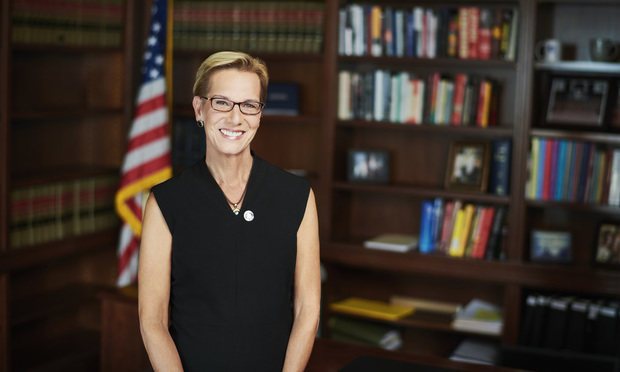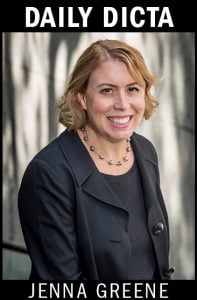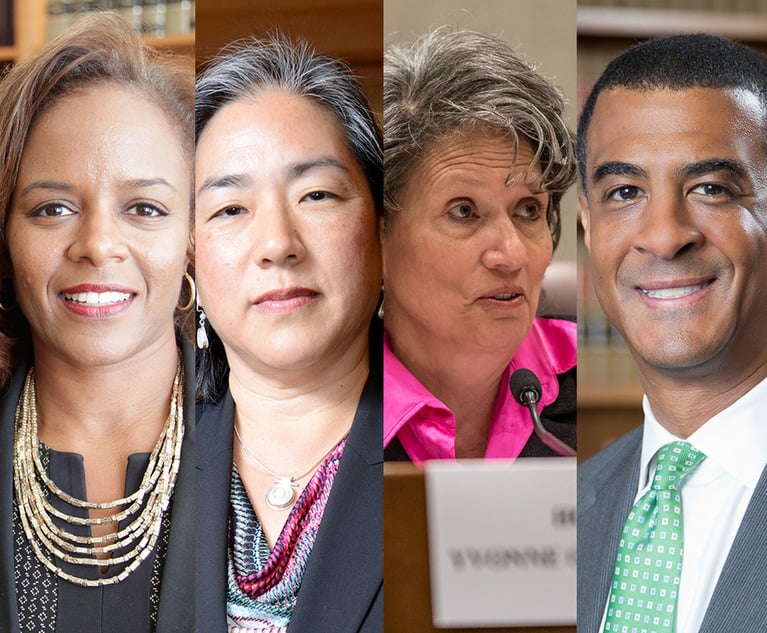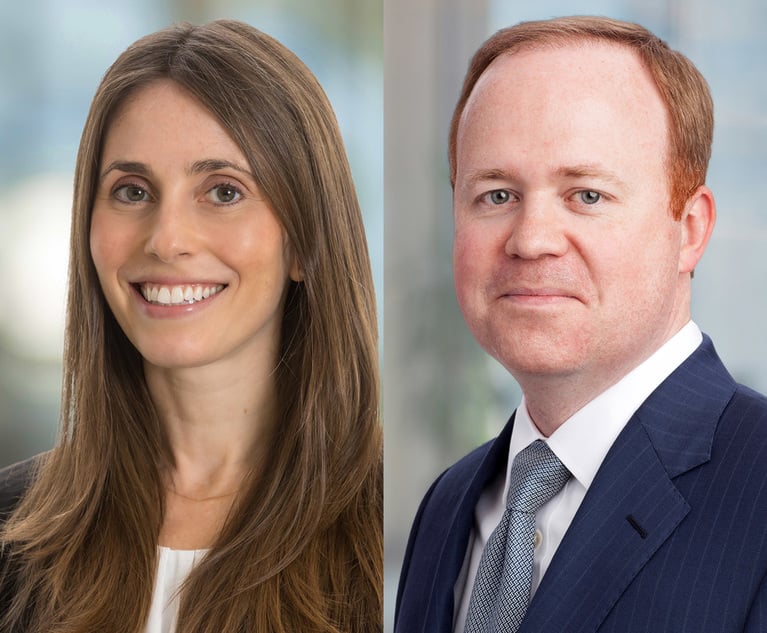Daily Dicta: Is Being a Federal Judge All That It's Cracked Up to Be?
After seven years on the bench, U.S. District Judge Katherine Forrest has re-joined Cravath, Swaine & Moore as a partner. Is it possible being a judge isn't the perfect job after all?
September 13, 2018 at 02:49 PM
7 minute read
 Katherine Forrest
Katherine Forrest
Making partner at a law firm, the old saying goes, is like winning a pie-eating contest where the prize is more pie.
But there are some obvious off-ramps to glory. You can become general counsel of a company, which in my imagination means flitting off to the Hamptons for the weekend while your outside counsel slaves away on a brief.
Or—even more elusive—you can be appointed as a federal judge. Not only do you get a robe and gavel and everyone has to call you “Your Honor” and stand when you walk into court—but you are (in the words of George W. Bush) The Decider.
You apply the law and call it like you see it. Sometimes you even make new law. You answer to almost no one, except maybe the court of appeals (and even then, it's not as if they can fire you). Long after you're gone, people will cite your opinions.
But what if what you really want is more pie?
On Wednesday, Cravath, Swaine & Moore announced that Katherine Forrest is rejoining the firm as a partner. In July, Forrest said she was retiring from the Southern District of New York, where she had been a judge since 2011.
“Retiring” in her case seems a bit misleading though, since she is 54.
 In July, Colby Hamilton writing for The New York Law Journal reported that Forrest told colleagues in an email that she was leaving the bench for “personal” reasons.
In July, Colby Hamilton writing for The New York Law Journal reported that Forrest told colleagues in an email that she was leaving the bench for “personal” reasons.
In a statement on Wednesday, Forrest said, “It has been an incredible privilege to serve as a member of the federal judiciary and to have served our justice system. I am thrilled to be coming home to begin the next phase of my career at Cravath, where I was trained and will have the opportunity to continue making a difference in the courtroom alongside a tremendous team.”
Which is nice, but I still wonder why someone gives up what is often viewed as the brass ring of the profession.
Might it be money? After all, a U.S. district court judge currently makes $208,000 a year—or just a hair more than a second-year associate at Cravath. Partners at the firm last year raked in an average of $4 million.
But Above the Law's David Lat pointed out in 2011, Forrest in her Senate Judiciary Committee questionnaire revealed that she's entitled to payments of $380,000 a year from Cravath until 2021. That would certainly help make ends meet on a judge's salary.
Forrest told The Wall Street Journal's Sara Randazzo that one reason she was leaving the bench is because she is going through a divorce. She was married to Sean Baldwin, a partner at Selendy & Gay (and former partner at Quinn Emanuel Urquhart & Sullivan).
Another clue for Forrest's move might be this phrase in her statement: “alongside a tremendous team.” Because being a district court judge is a rather solitary job.
Sure, a judge has clerks and court staff, and there are other judges in neighboring chambers to chat with. But as a litigator, you work with junior and senior lawyers and staff within your firm, in-house counsel, witnesses, experts, perhaps co-counsel—plus there's opposing counsel to spar with. It's a far more sociable, team-oriented occupation.
Judges can also face disquieting reactions to their decisions.
In 2015, Forrest sentenced Ross Ulbricht to life in prison without parole for his role in the Silk Road online black market. Even now, when you search her name you can easily find vitriolic, profanity-laden threats (I refuse to link to them) that also mention her two children and a “bounty for anyone who can get info on them.”
To be sure, Forrest isn't the only federal judge to go back to a law firm.
But more often, the move comes after many years as a judge, a sort of bookend to a legal career. Think Barbara S. Jones to Bracewell or John Gleeson to Debevoise & Plimpton or Shira Scheindlin to Stroock & Stroock & Lavan or Jorge Solis to Katten Muchin Rosenman or Leonard Davis to Fish & Richardson.
Less common are those who, like Forrest, leave during the prime of their career after just a few years on the bench.
Hausfeld partner Walter Kelley Jr. spent less than four years as a judge in the Eastern District of Virginia before he resigned in 2008. “I don't so much enjoy the day-to-day drugs and guns and immigration cases that make up much of our docket,” he told the Virginian-Pilot when he quit to join Jones Day. “Other people enjoy it and don't like what I like—the big, complicated cases.”
As a top litigator at Cravath, Forrest is all but guaranteed a steady diet of big, complicated cases. In other words, enjoy the pie.
For more, see Ex-SDNY Judge Katherine Forrest Returns to Cravath
Note: this post was updated to include information from The Wall Street Journal
What I'm Reading
Ex-Dickstein Shapiro Lawyers Sue Blank Rome for $4 Million in Unreturned Capital
Sixteen former Dickstein Shapiro partners have sued Blank Rome claiming the 2016 merger between the two firms was inappropriately styled as a sale to avoid paying out more than $4 million in capital accounts owed to former partners.
'Low Testosterone' Cases Come to an End Via Settlement
The confidential global settlement resolves more than 4,000 cases and comes after the defense has racked up a series of wins.
GM Ignition Switch Litigation Advances in NY Federal Court With State Liability Rulings
The judge rejected GM's argument that the plaintiffs cannot recover for economic loss unless their vehicles had a malfunction.
Trump's Tax Returns Get Their Day in the DC Circuit
The court will hear arguments today to decide whether the Internal Revenue Service can be forced to publicly release Trump's tax returns through the federal Freedom of Information Act.
Courthouse Asbestos Claim by Trial Judge's Widow Rejected on Appeal
The widow of a longtime trial court judge claimed her late husband was exposed to asbestos during remediation at the Jefferson County Courthouse in the mid-1990s.
Suit Claims Steve Harvey Execs Fired Woman Who Refused Their Sex Requests
According to the plaintiff, the exec and his secretary wanted a threesome.
In case you missed it
CBS legal correspondent Paula Reid went to bat for Covington and Debevoise in a tweet.
NOT FOR REPRINT
© 2025 ALM Global, LLC, All Rights Reserved. Request academic re-use from www.copyright.com. All other uses, submit a request to [email protected]. For more information visit Asset & Logo Licensing.
You Might Like
View All
‘Listen, Listen, Listen’: Some Practice Tips From Judges in the Oakland Federal Courthouse

Litigators of the Week: A Knockout Blow to Latest FCC Net Neutrality Rules After ‘Loper Bright’

An ‘Indiana Jones Moment’: Mayer Brown’s John Nadolenco and Kelly Kramer on the 10-Year Legal Saga of the Bahia Emerald

Litigators of the Week: A Win for Homeless Veterans On the VA's West LA Campus
Trending Stories
- 1States Accuse Trump of Thwarting Court's Funding Restoration Order
- 2Microsoft Becomes Latest Tech Company to Face Claims of Stealing Marketing Commissions From Influencers
- 3Coral Gables Attorney Busted for Stalking Lawyer
- 4Trump's DOJ Delays Releasing Jan. 6 FBI Agents List Under Consent Order
- 5Securities Report Says That 2024 Settlements Passed a Total of $5.2B
Who Got The Work
J. Brugh Lower of Gibbons has entered an appearance for industrial equipment supplier Devco Corporation in a pending trademark infringement lawsuit. The suit, accusing the defendant of selling knock-off Graco products, was filed Dec. 18 in New Jersey District Court by Rivkin Radler on behalf of Graco Inc. and Graco Minnesota. The case, assigned to U.S. District Judge Zahid N. Quraishi, is 3:24-cv-11294, Graco Inc. et al v. Devco Corporation.
Who Got The Work
Rebecca Maller-Stein and Kent A. Yalowitz of Arnold & Porter Kaye Scholer have entered their appearances for Hanaco Venture Capital and its executives, Lior Prosor and David Frankel, in a pending securities lawsuit. The action, filed on Dec. 24 in New York Southern District Court by Zell, Aron & Co. on behalf of Goldeneye Advisors, accuses the defendants of negligently and fraudulently managing the plaintiff's $1 million investment. The case, assigned to U.S. District Judge Vernon S. Broderick, is 1:24-cv-09918, Goldeneye Advisors, LLC v. Hanaco Venture Capital, Ltd. et al.
Who Got The Work
Attorneys from A&O Shearman has stepped in as defense counsel for Toronto-Dominion Bank and other defendants in a pending securities class action. The suit, filed Dec. 11 in New York Southern District Court by Bleichmar Fonti & Auld, accuses the defendants of concealing the bank's 'pervasive' deficiencies in regards to its compliance with the Bank Secrecy Act and the quality of its anti-money laundering controls. The case, assigned to U.S. District Judge Arun Subramanian, is 1:24-cv-09445, Gonzalez v. The Toronto-Dominion Bank et al.
Who Got The Work
Crown Castle International, a Pennsylvania company providing shared communications infrastructure, has turned to Luke D. Wolf of Gordon Rees Scully Mansukhani to fend off a pending breach-of-contract lawsuit. The court action, filed Nov. 25 in Michigan Eastern District Court by Hooper Hathaway PC on behalf of The Town Residences LLC, accuses Crown Castle of failing to transfer approximately $30,000 in utility payments from T-Mobile in breach of a roof-top lease and assignment agreement. The case, assigned to U.S. District Judge Susan K. Declercq, is 2:24-cv-13131, The Town Residences LLC v. T-Mobile US, Inc. et al.
Who Got The Work
Wilfred P. Coronato and Daniel M. Schwartz of McCarter & English have stepped in as defense counsel to Electrolux Home Products Inc. in a pending product liability lawsuit. The court action, filed Nov. 26 in New York Eastern District Court by Poulos Lopiccolo PC and Nagel Rice LLP on behalf of David Stern, alleges that the defendant's refrigerators’ drawers and shelving repeatedly break and fall apart within months after purchase. The case, assigned to U.S. District Judge Joan M. Azrack, is 2:24-cv-08204, Stern v. Electrolux Home Products, Inc.
Featured Firms
Law Offices of Gary Martin Hays & Associates, P.C.
(470) 294-1674
Law Offices of Mark E. Salomone
(857) 444-6468
Smith & Hassler
(713) 739-1250






